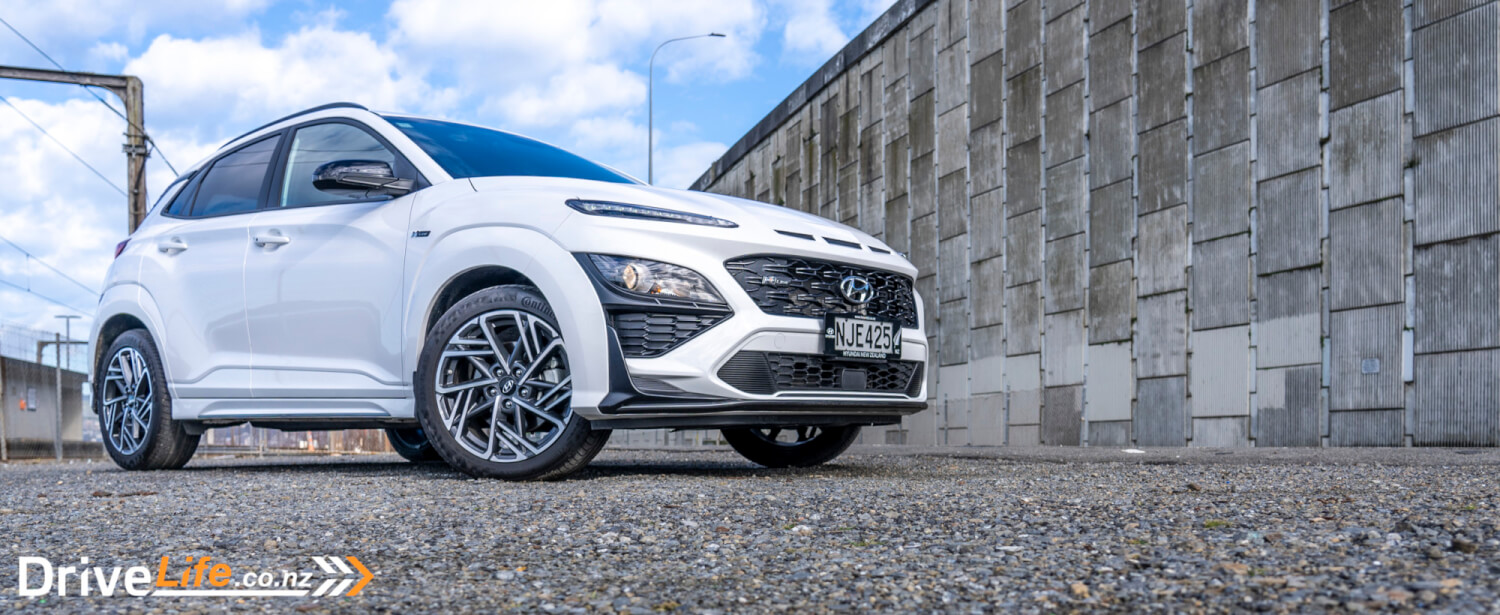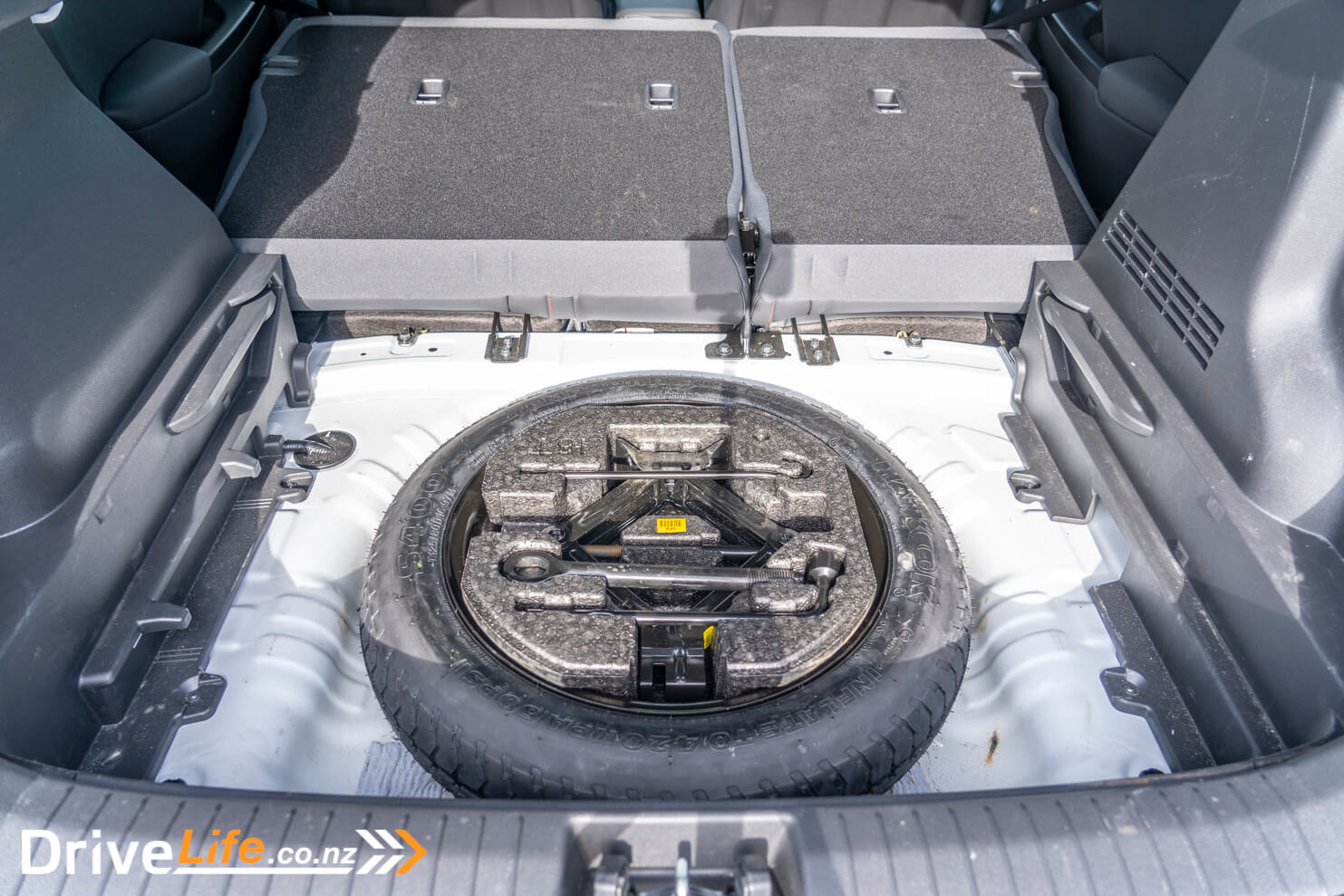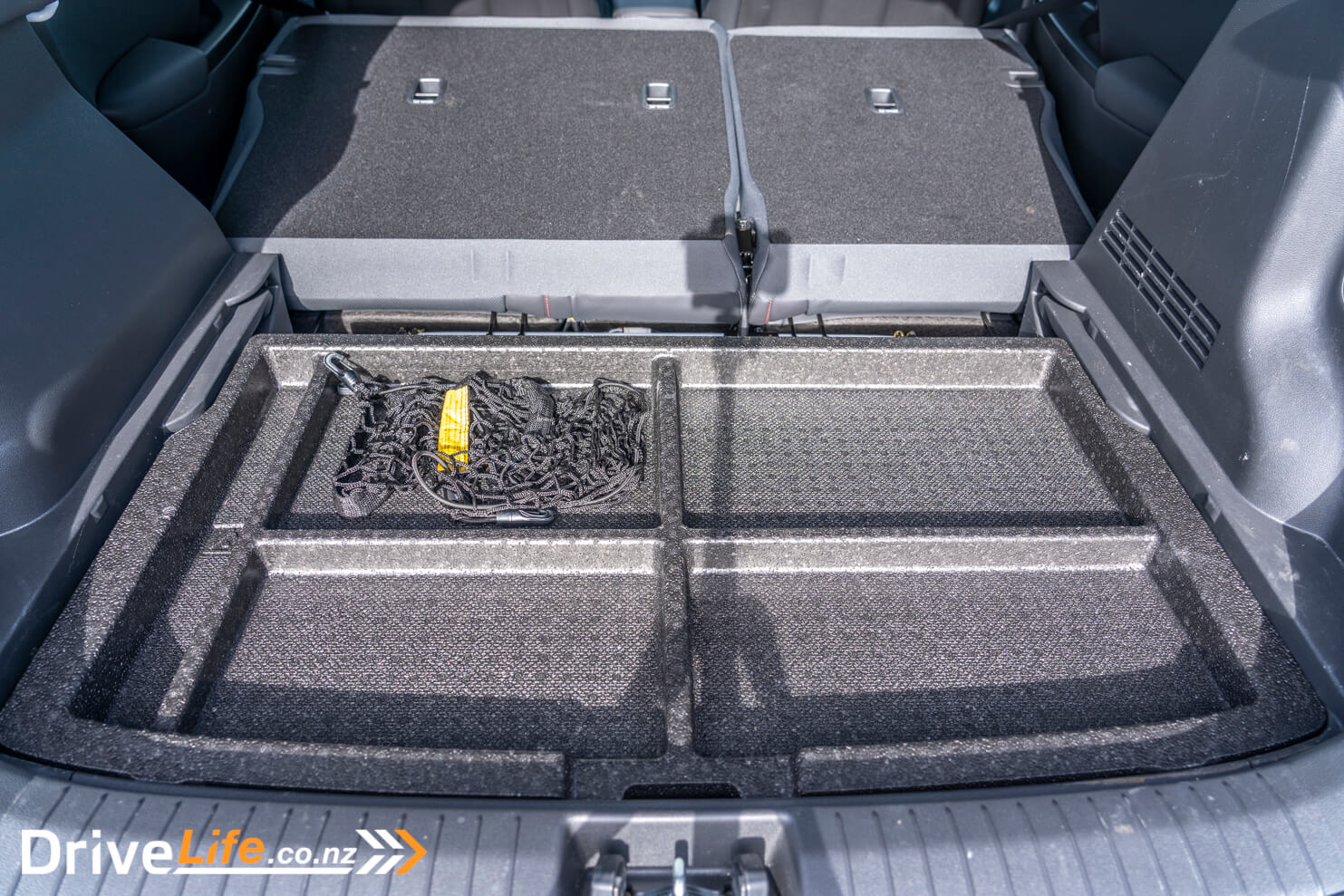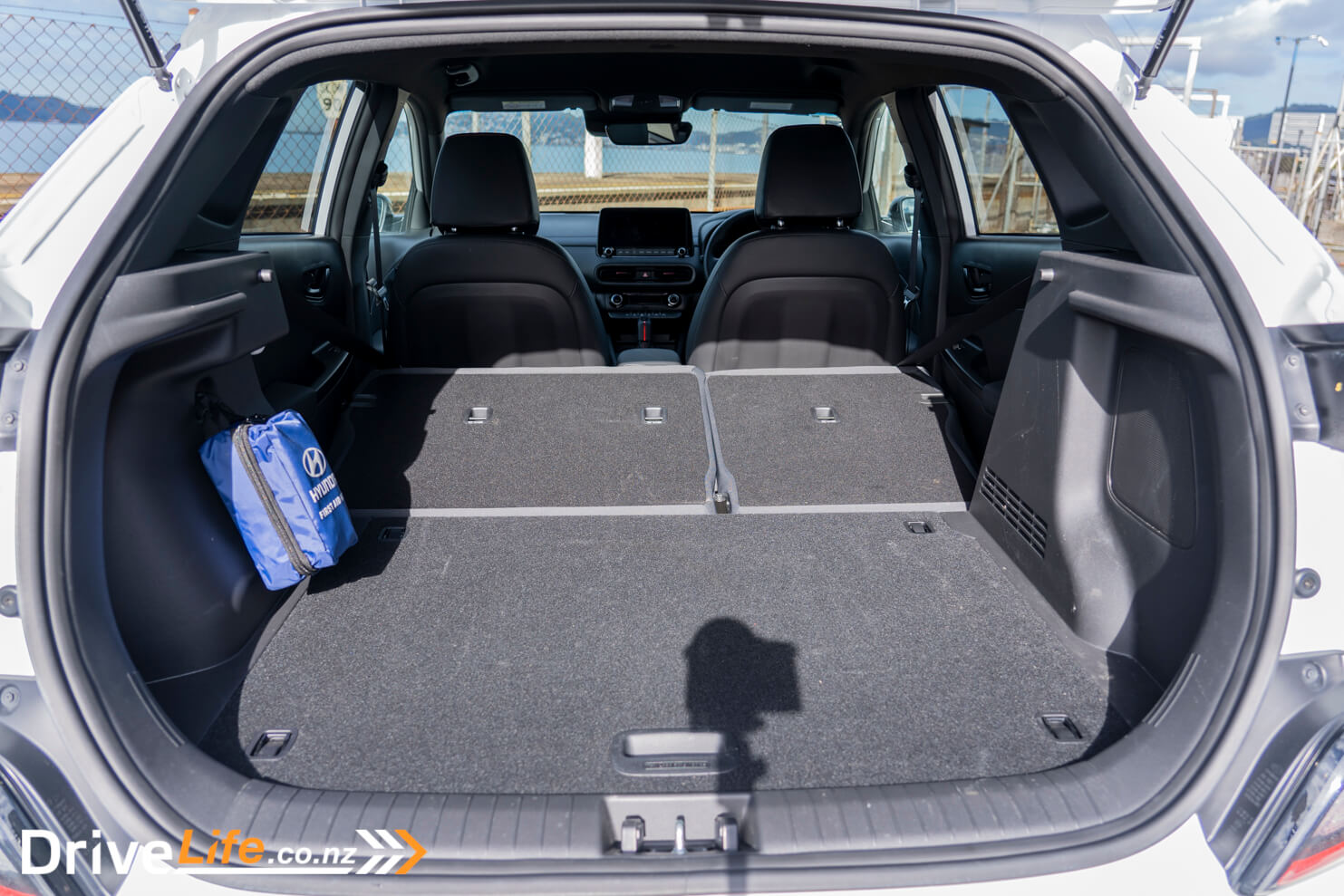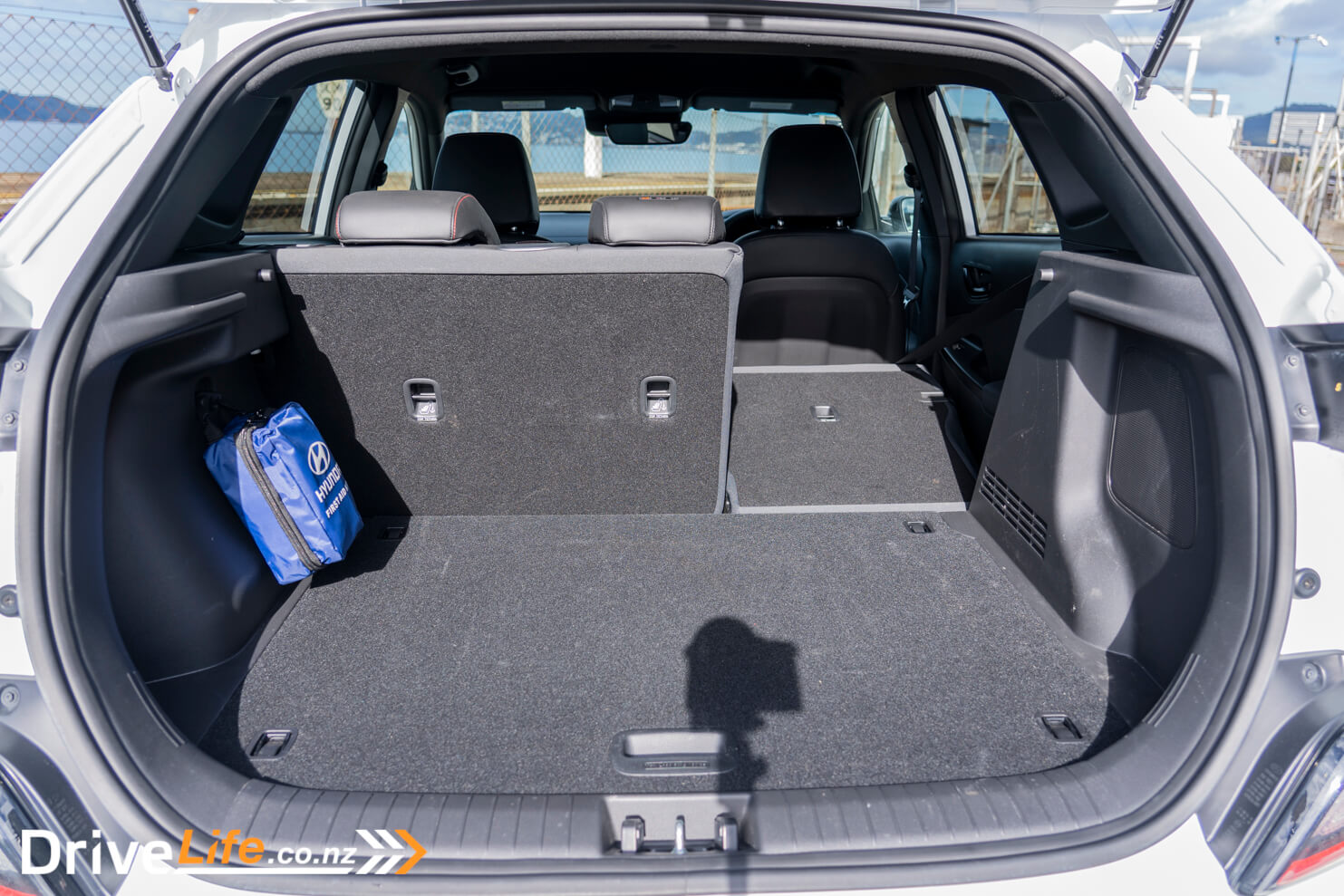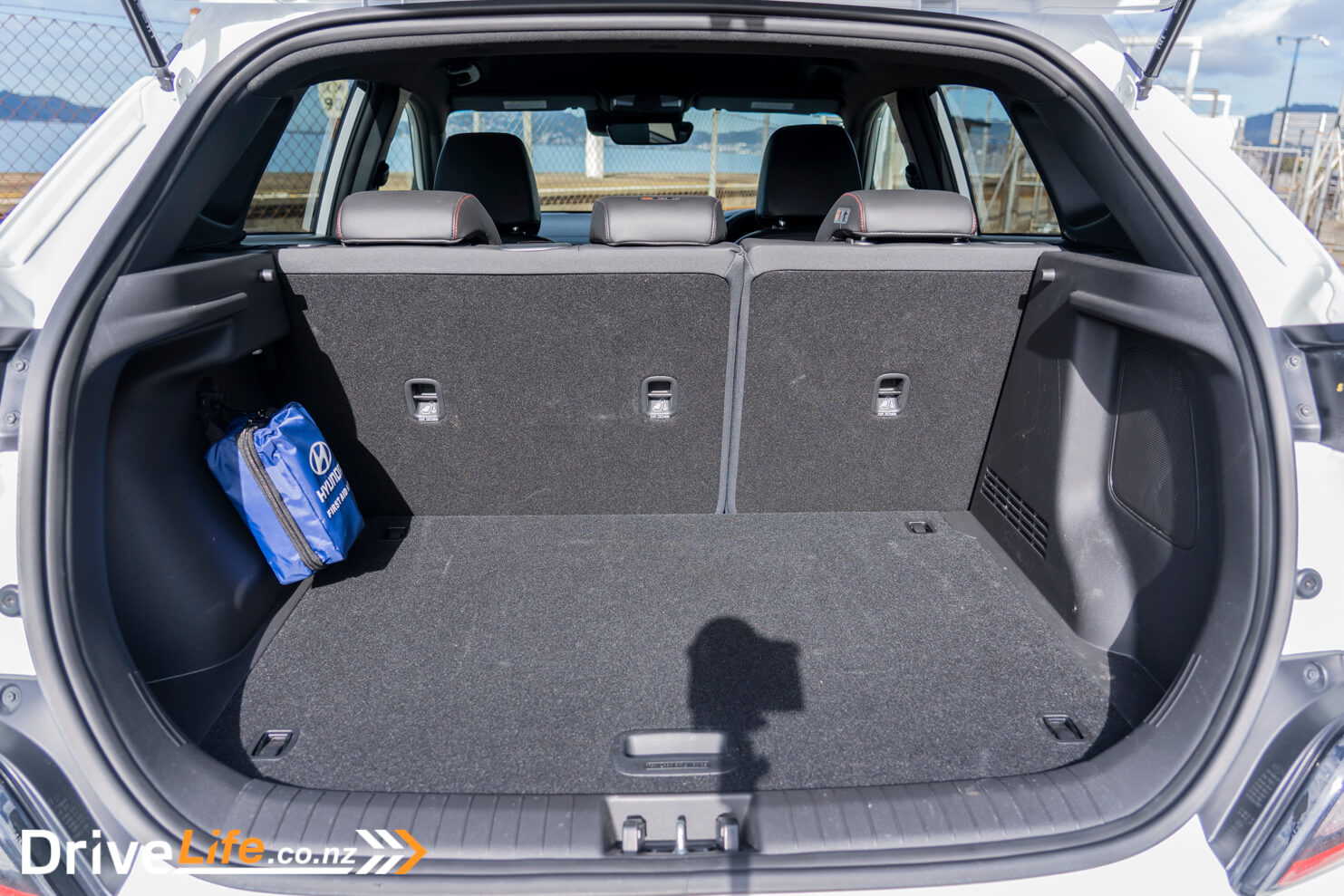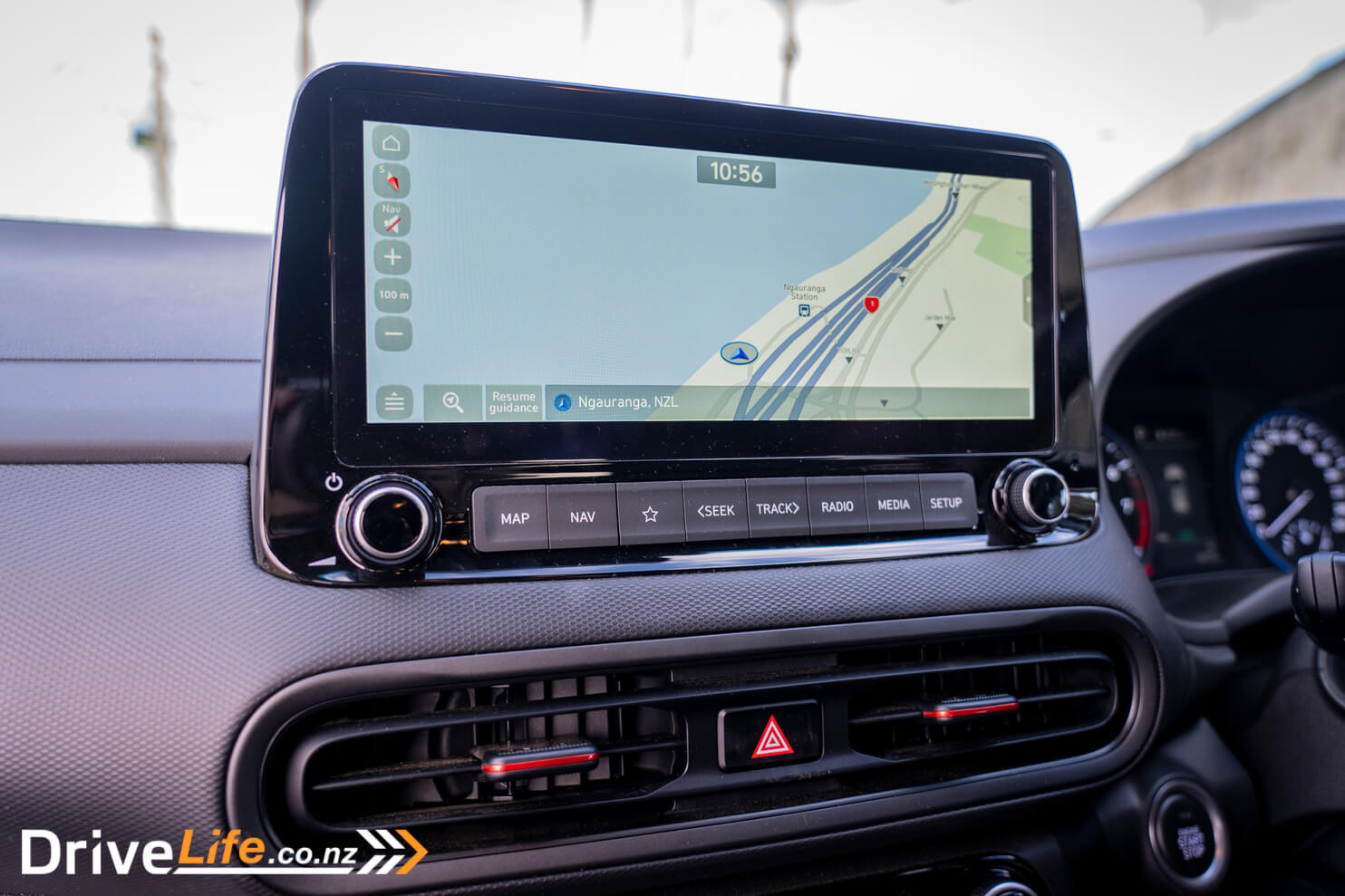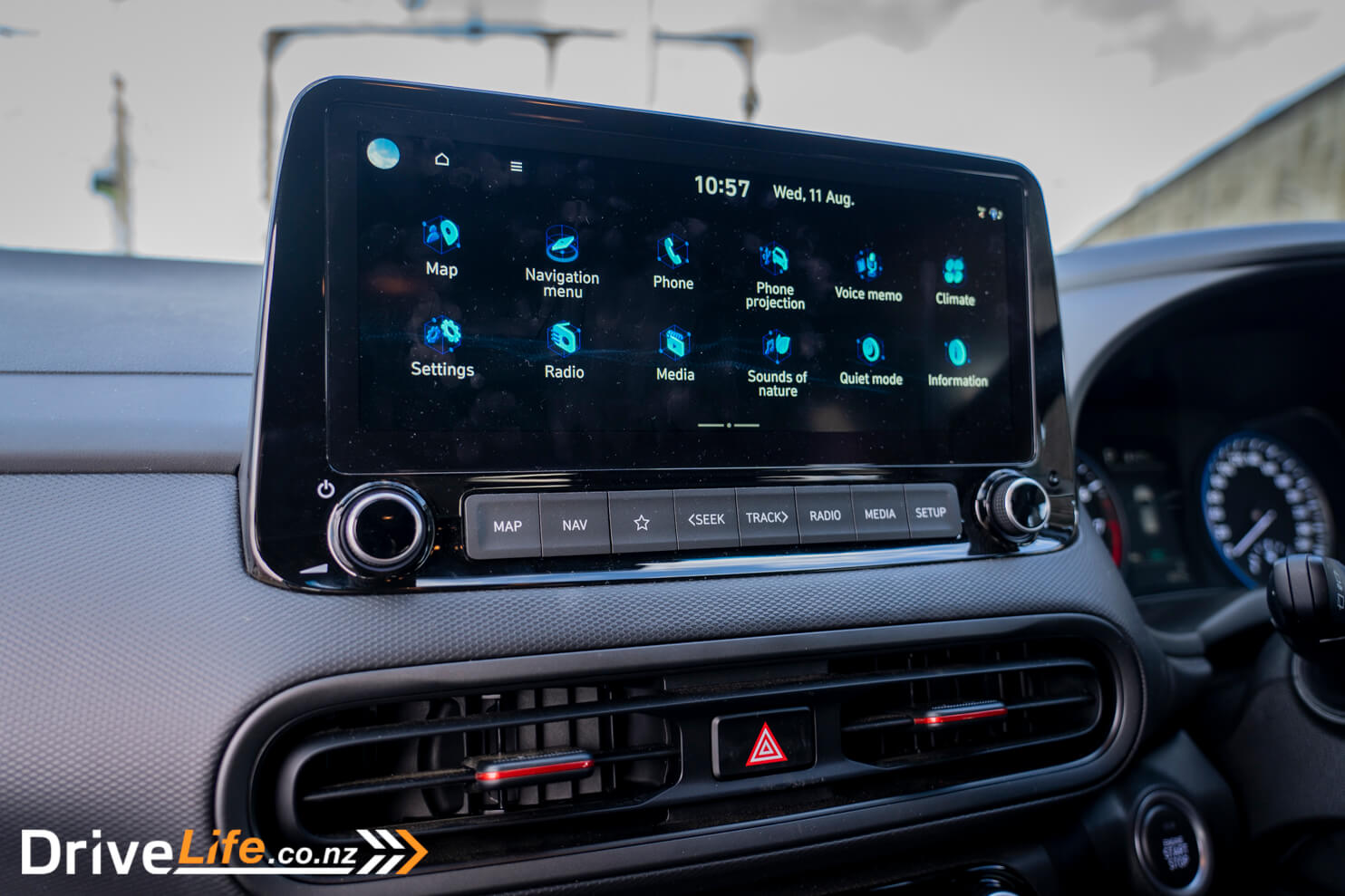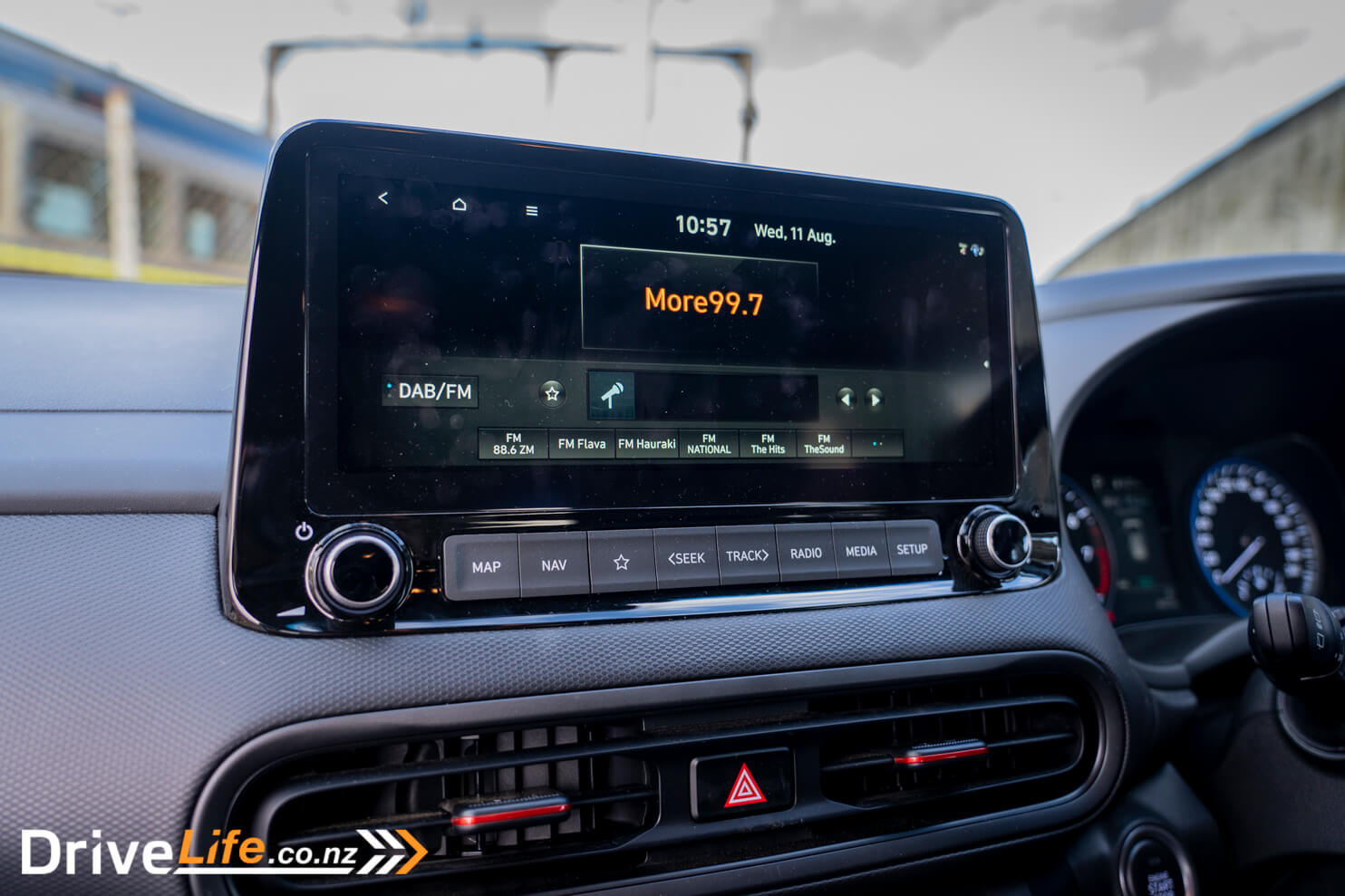It’s been a while since I’ve been in a Kona, and in fact the last one was in 2018 with a Gen1 EV model that my wife and I drove to Auckland, and back. We have fond memories of that trip, mainly that a long trip with an EV wasn’t really an issue at all.
2021 brings the Gen2 version of the Kona, and this time, I’m in the more sporty version; the 146kW N Line.
At $49,990, is it worth paying $10K over the Elite model to get 36 more kilowatts? And perhaps more importantly, is the 2021 Hyundai Kona N Line a car that has no market?
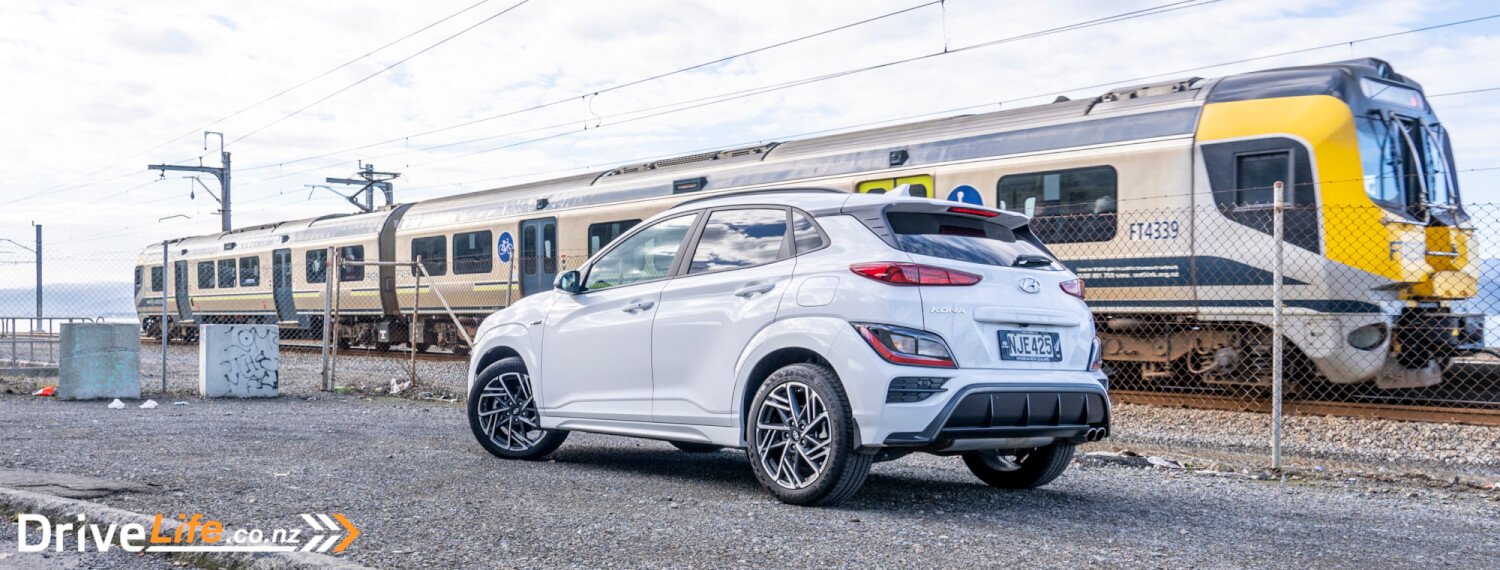
2021 Hyundai Kona N Line – First Impressions
Well, at least it’s not grey. That Kona EV we took on a trip to Auckland was so much grey, and it was not a car that popped in photos. I have to say, Hyundai have done well with the facelift. The front looks exactly as you’d expect a Kona to look, yet it’s freshened up with a much more futuristic front end without going over the top into weirdness.
Instead of the rugged skid plate of the new Kona, the N Line version features a characteristic N-style aerodynamic lip with low-lying corner fins for what Hyundai says is “a road-hugging appearance”. Larger, more technical air intake features are further distinguished by a unique mesh design and surface treatment.
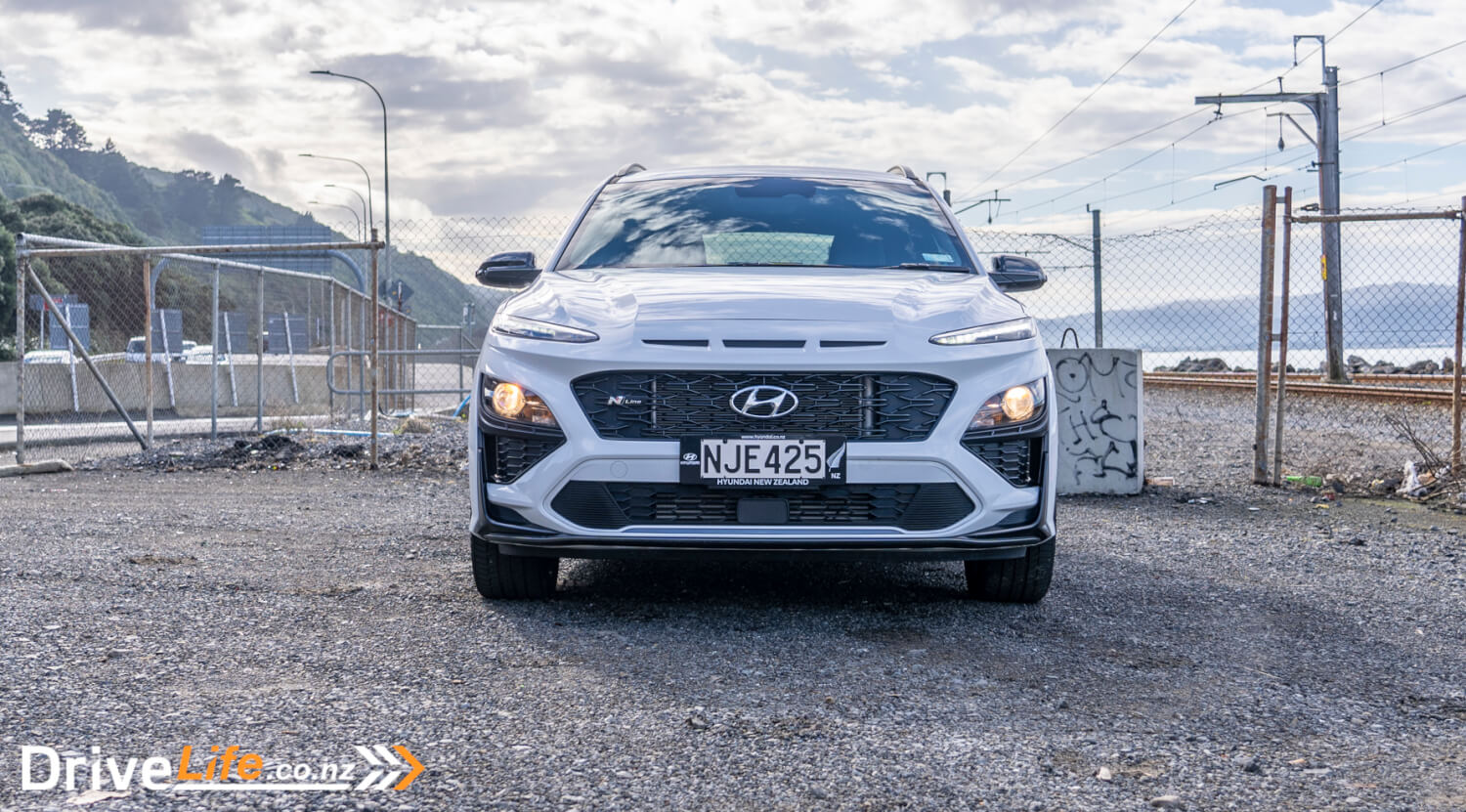
In N Line guise, it’s a sharp-looking car, especially up front. I’ll be honest and say I’ve always liked the look of the Kona. Sure, there’s a lot happening head-on, but in times when it’s getting harder to distinguish different brands or models of SUV, the Kona is distinctive – there’s no mistaking it for something else coming towards you on the road.
Around the back things start to get a little busy. There seems to be taillights on taillights, and while the car certainly doesn’t look that much different from the previous generation, the front, sides and rear of the car have all been updated, but it’s fairly subtle. At the rear, there’s new taillights and a new bumper design. Those dual exhaust tips give the game away that this isn’t the Elite or Limited model.
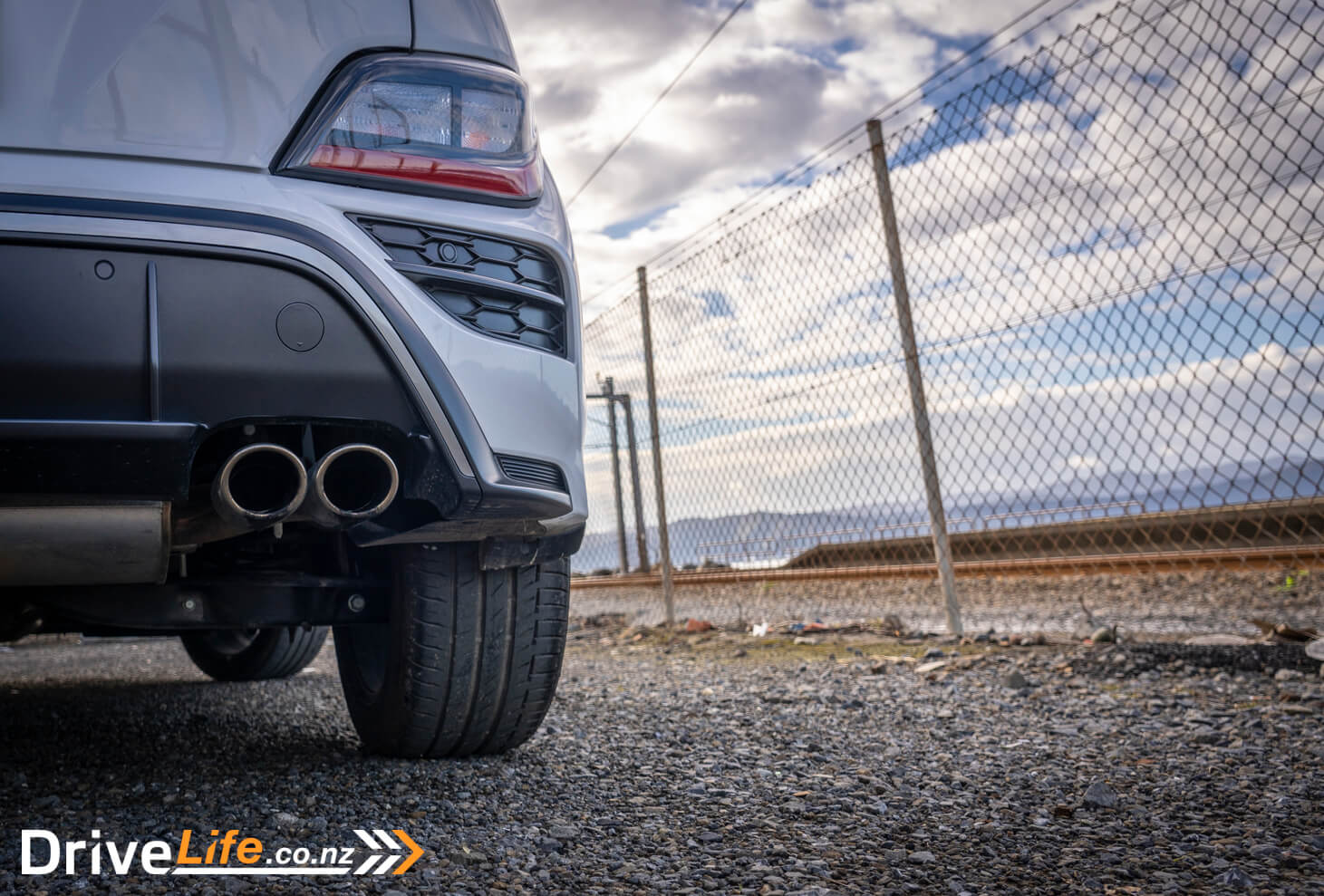
The rear bumper incorporates a large central aerodynamic diffuser in a contrast colour to the body, and the bumper fascia is formed with sharply creased corners and N-style fins for better airflow.

What’s In The 2021 Hyundai Kona N Line Range
There’s a range of 4 Konas to pick from if you exclude the EV model. At the bottom end is the $34,990 Entry, powered by a 2-litre, 4-cylinder petrol engine that manages 110kW of power and 180Nm of torque. It’s joined to a CVT automatic transmission, and this engine/gearbox combo is used across the range, except for the N Line of course.
The N Line has a 1.6-litre, turbocharged four-cylinder petrol engine giving you 146kW/265Nm. It has a 7-speed dual-clutch automatic transmission instead of the CVT.
The Entry model has 17” alloy wheels, a tyre pressure monitoring system, an electric park brake with auto hold, electric folding and heated exterior mirrors, LED DRLs, a roof spoiler with LED stoplight, a leather steering wheel and gearshift gaiter, keyless entry, an 8” central touchscreen, Apple CarPlay and Android Auto, a 4-speaker audio system, and a 4.2” colour driver’s information display.
Moving up to the $39,990 Elite model, you also get privacy & solar glass, 18” alloys, a full leather interior, an 8-way electric driver’s seat, 6-way electric passenger’s seat, heated front seats, wireless smartphone charging, keyless start, a 10.25” central touchscreen, SatNav, A Harmon Kardon 8-speaker audio system, and climate AC. The Elite certainly seems to be the sweet spot of the range.
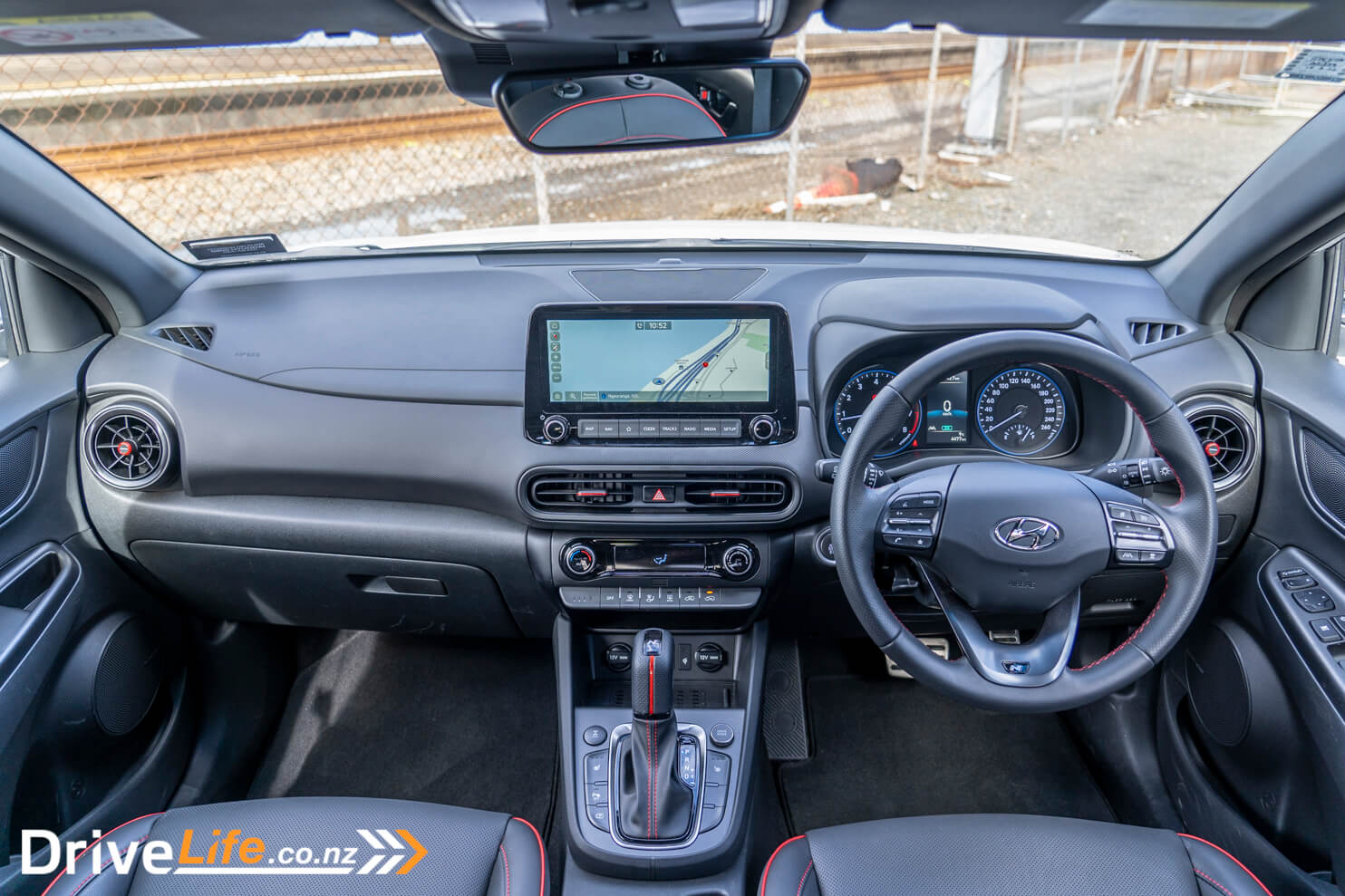
For $5,000 more ($44,990), the Limited version has bi-LED headlights, heated rear seats, LED taillights, wireless Apple CarPlay and Android Auto, ventilated front seats, a heads-up display, and lastly a 10.25” colour driver’s information display.
At $49,990, the Kona N line doesn’t have any of those Limited extras; it’s kitted out the same as the Elite model.
Your Kona comes with lots of safety systems, with even the base model having Blind Spot Collision Avoidance, Forward Collision Avoidance, Lane Keep Assist, adaptive cruise control with stop/go, 6 air bags, automatic headlights, rear park assist system, a reversing camera, and a first aid kit. As far as safety goes, the Elite adds an automatic dipping rearview mirror and automatic wipers. The Limited then adds automatic high beam headlights and front park assist system. Weirdly, the Kona N Line loses both of those items so safety equipment is at the Elite level.
Colours available are Surfy Blue, Dive in Jeju, Ignite Flame, Cyber Grey, and Misty Jungle. These are in addition to five existing colours, including Phantom Black, Chalk White, Dark Knight, Pulse Red and Galactic Grey. Every colour can be combined with the Phantom Black two-tone roof, and the two-tone roof also comes with matching mirror housings.
Check out the Hyundai New Zealand website for more Kona information.
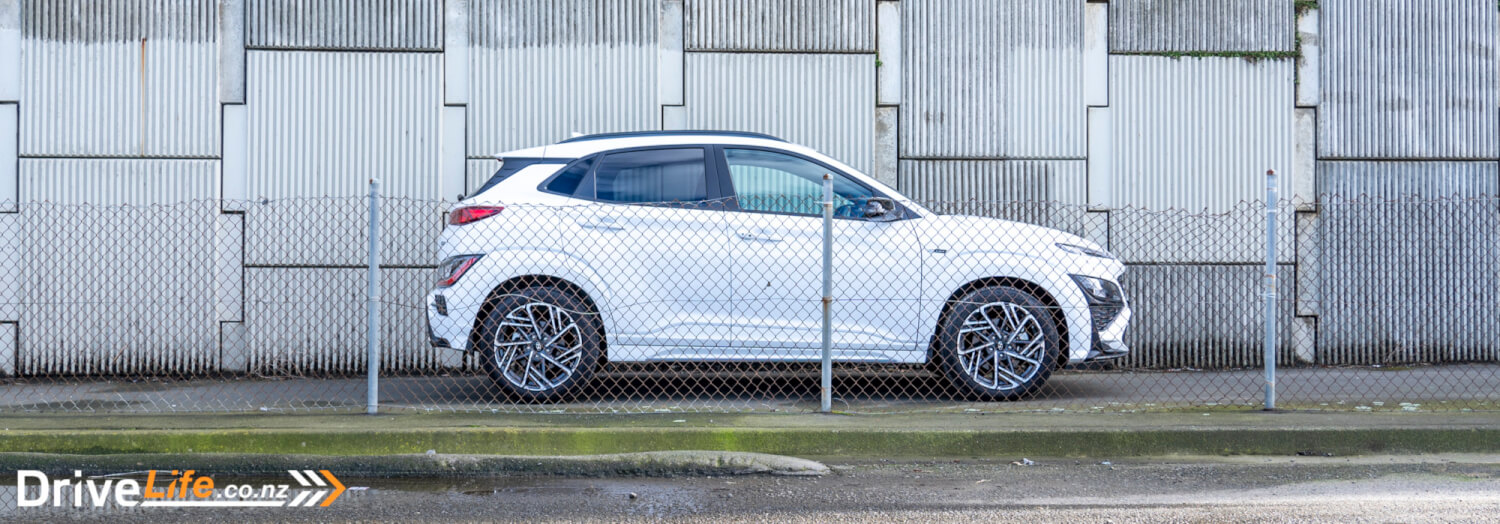
2021 Hyundai Kona N Line – What’s The Interior Like?
I was really expecting something special inside the car – this is the N Line, after all – but it’s all fairly standard Kona. For the N Line, there is some red stitching on the seats, steering wheel and transmission gaiter, and the top of the seats have an ‘N’ logo on them. It also has some ‘anodised’ red plastic bits around the cabin and there’s metal pedals, but other than that there’s no distinction between the N Line and other models.
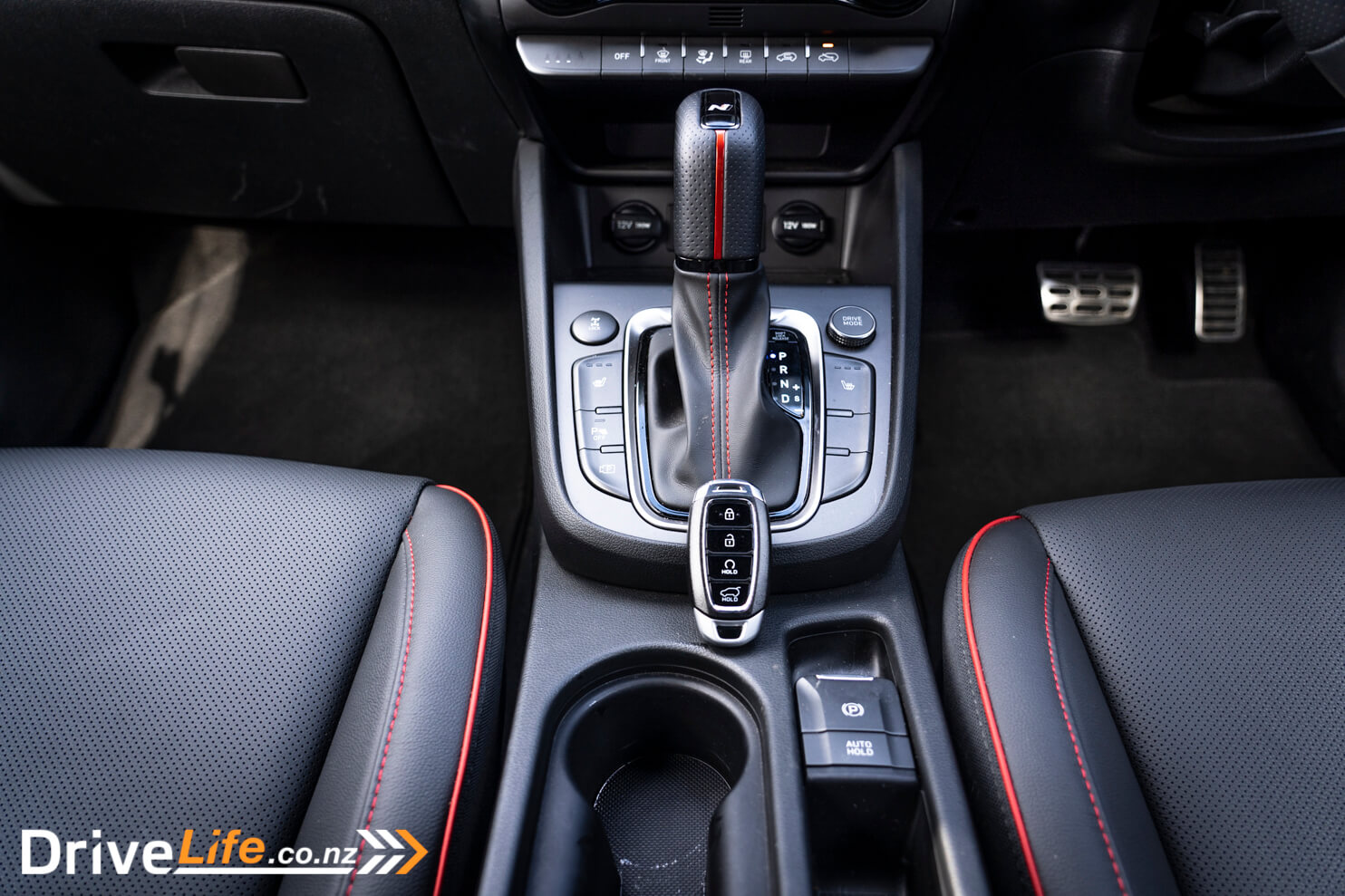
All the controls look and feel the same as the previous gen, but there is that centre display that’s much bigger at 10.25” and has a lot more clarity – it’s a massive improvement over the previous model. The new (touch) screen also comes with a split-screen function and allows multiple Bluetooth connections, and it’s nicely quick between screens.
The steering wheel controls are identical to the previous gen too, but I’m happy about that. After a run of cars that have moved to haptic steering wheel controls, I was very happy to see that Hyundai haven’t jumped on that bandwagon; their steering wheel controls are simple to use without looking down, and that’s a win.
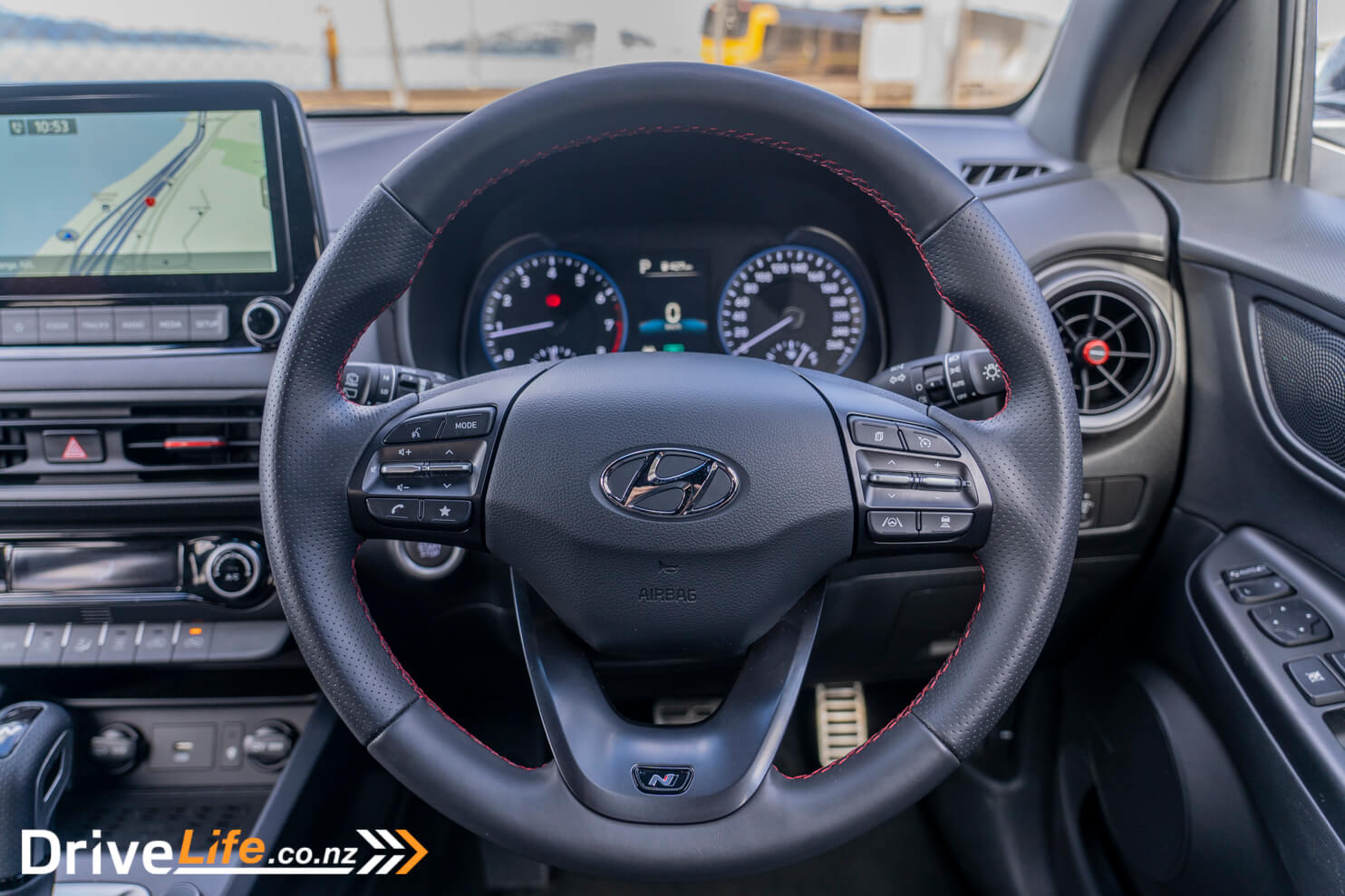
The interior does feel very cheap, and plasticky. Hyundai has tried to use some different textures, but it feels like a sub-$30K car, not a $50K one. Both Hyundai and Kia have made leaps and bounds in the use of interior materials and textures lately, so it was a bit disappointing to see that the interior of the Kona is pretty much untouched in this department.
But there have been other improvements over the previous model, with extra rear legroom, more cargo space, a redesigned console and a move to an electric park brake. There’s also new ambient light technology that illuminates the centre cup holders as well as in the passenger and driver side footwells, and new aluminium finish rings around the speakers and air vents.
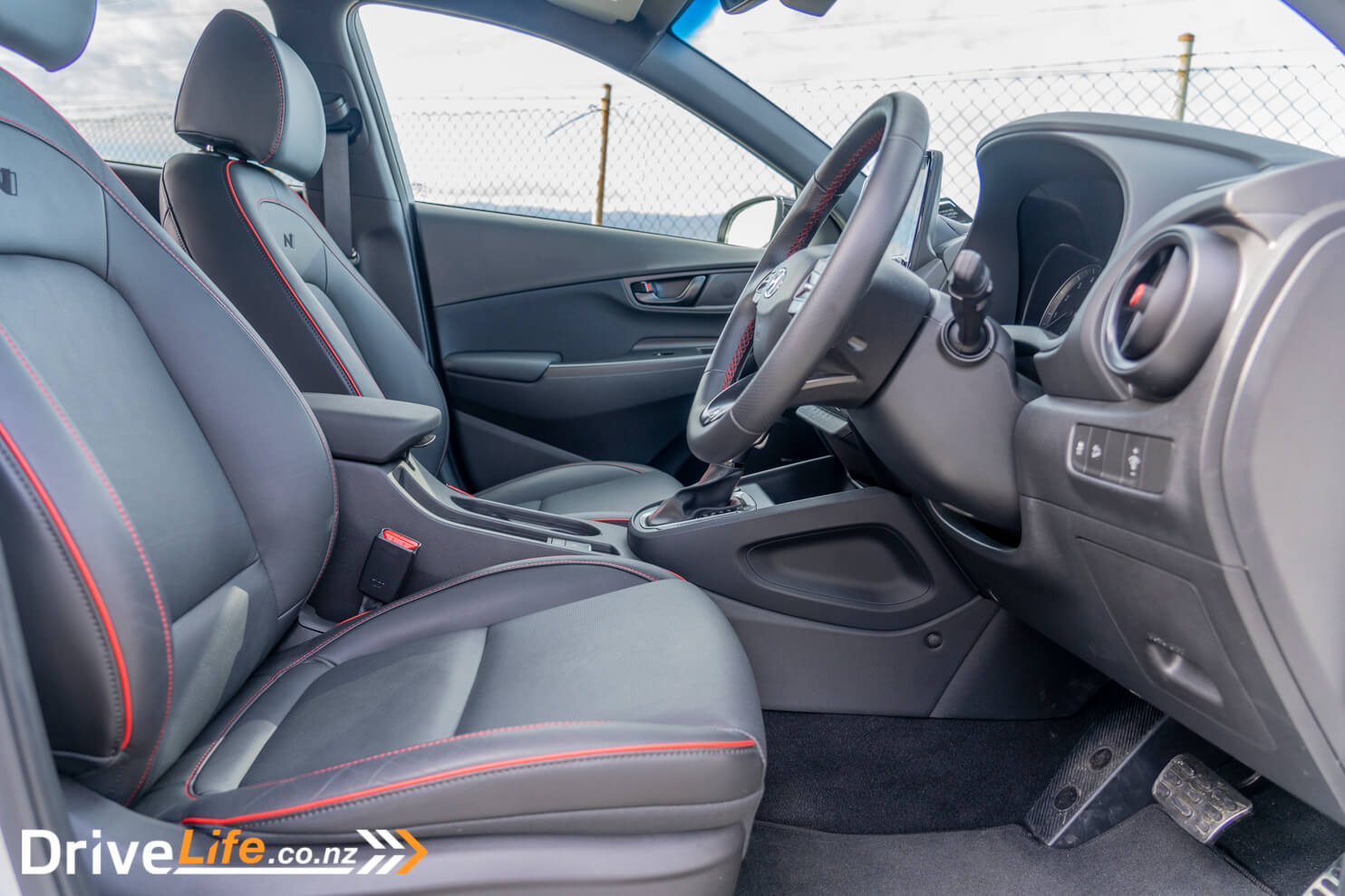
The second row can also be adjusted for height, and I expect passengers who sometimes feel car sick will appreciate being able to lift the seat up that bit higher.
The centre console has a camera button and I was expecting this to be a 360-degree camera, but there isn’t one. The button simply turns on the reversing camera manually.
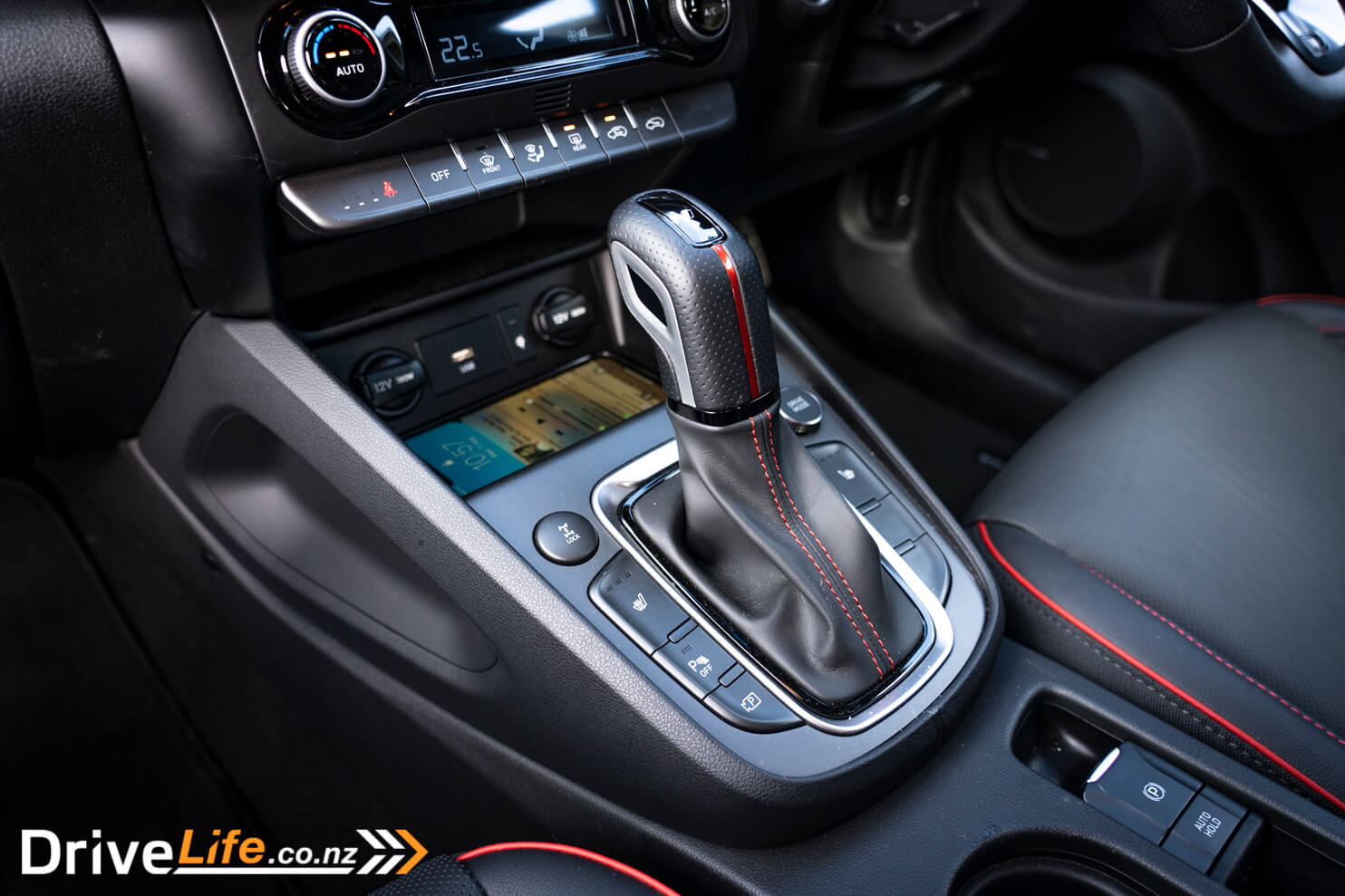
Front seat passengers get access to two 12-volt power sockets and one USB port, and of course there are heated seats up front as well. With the cold snap during my time with the Kona, these felt essential. Another item that’s becoming more essential is the Qi wireless phone charger, and the N Line has one. It’s in a perfect place right up front of the console, and holds your phone well, so it doesn’t float about and go off charge. I did take the car over to Masterton during my week, and even with some ‘spirited’ driving, my cell didn’t budge.
While rear legroom has increased over the previous model (the new Kona is 40mm longer than the old one), it’s still average for the class. Rear seat passengers don’t get any air vents, but they do have a single USB port for charging phones.

The new gen Kona features Rear Occupant Alert (ROA), which alerts the driver if someone or something is in the back seat when they prepare to exit the vehicle. Another safety feature primarily intended for the protection of children, Safe Exit Warning (SEW) is intended to prevent passengers from exiting the vehicle if it is not yet safe to do so. If the vehicle has come to a stop, but the radar detects an oncoming vehicle coming from the rear, it will display a visual and audible warning to alert the passenger of the danger. SEW really works to keep you and your passengers from opening your door into oncoming traffic.
In the back of the car, there’s some slim but usable space under the floor, on top of the spare wheel. It’s a space-saver spare, but hey – these days when lots of cars are coming out with just a pump, be thankful for that space-saver.
What Does The 2021 Hyundai Kona N Line Drive Like?
After pairing up my phone – which took 1 minute – I headed out into the traffic in the N Line. I had two first impressions; 146kW in an SUV this size is plenty. With the weight of the car it feels like it has more power than it does. It’s peppy and will accelerate briskly at the drop of an accelerator pedal. Think of a Meerkat sitting up asking “Go now? Go now?” all the time. That’s the Hyundai Kona N Line.
In this respect, it reminds of the Kia Soul Turbo I tested way back in 2017. That car was this eager too, and while the Soul was just too much (with its 1.6-litre turbo 4-cylinder and 150kW), the N Line is (mostly) much more driveable, probably due to its all-wheel-drive (AWD) system.
I said there were two first impressions, and the second one is not so good. The Kona N Line has a 7-speed dual-clutch transmission (DCT) and it lets the car down quite badly. On the move it’s just fine, with quick changes and nice manners. But around town, it’s painful. It’s very slow to disengage the clutch from a stop, and it detracts from the overall smoothness of the car. The DCT rides the clutch a lot when it’s not quite ready to go, and at times it’s a bit embarrassing, for example if someone lets you into a lane and you touch the gas pedal and then wait for the car to eventually move forward. I don’t want to go on about it too much, but it’s a major area that needs improvement. This is where a straight torque-convertor automatic wins hands-down over a DCT. Please Hyundai, fix this transmission.
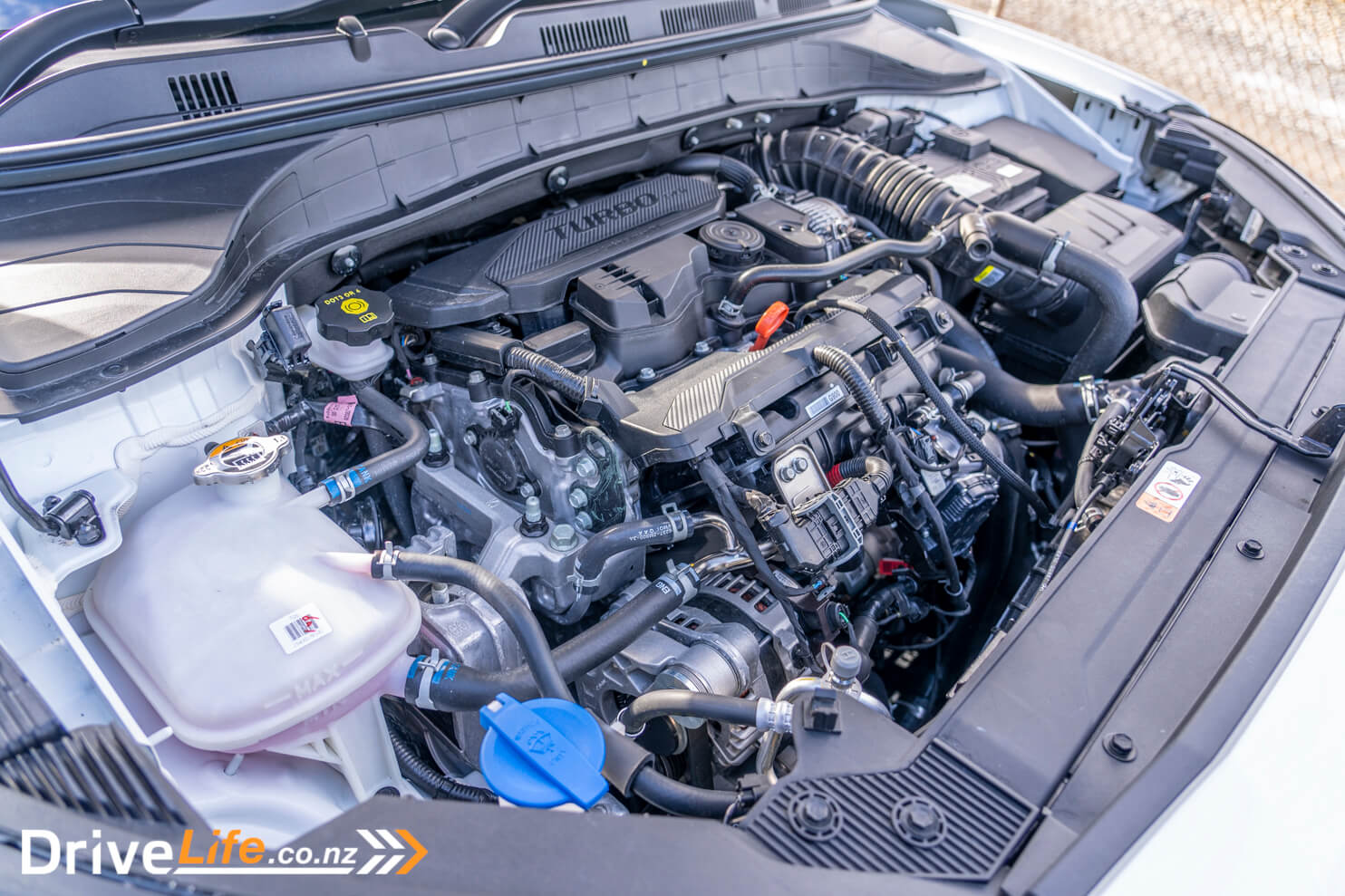
The 1.6-turbo engine is smooth, right out the 7K red line. It can get a bit noisy and rattly above 4,000rpm, and unfortunately, if you are wanting to make the most of the engine, it needs to be kept above 4K RPM. Don’t expect any crackles and pops though; the Kona N Line’s exhaust is neighbour-friendly, even in Sport mode. I expect the new Kona N (when it gets here) will be a lot more childish in this department.
In Sport mode, the car instantly gets more responsive, as you’d expect. The dash is nice and clear, a model of crispness. But it’s not active in any way, so sticking the car into Sport mode will only see the word ‘SPORT’ in red come up on the dash, and that’s it.
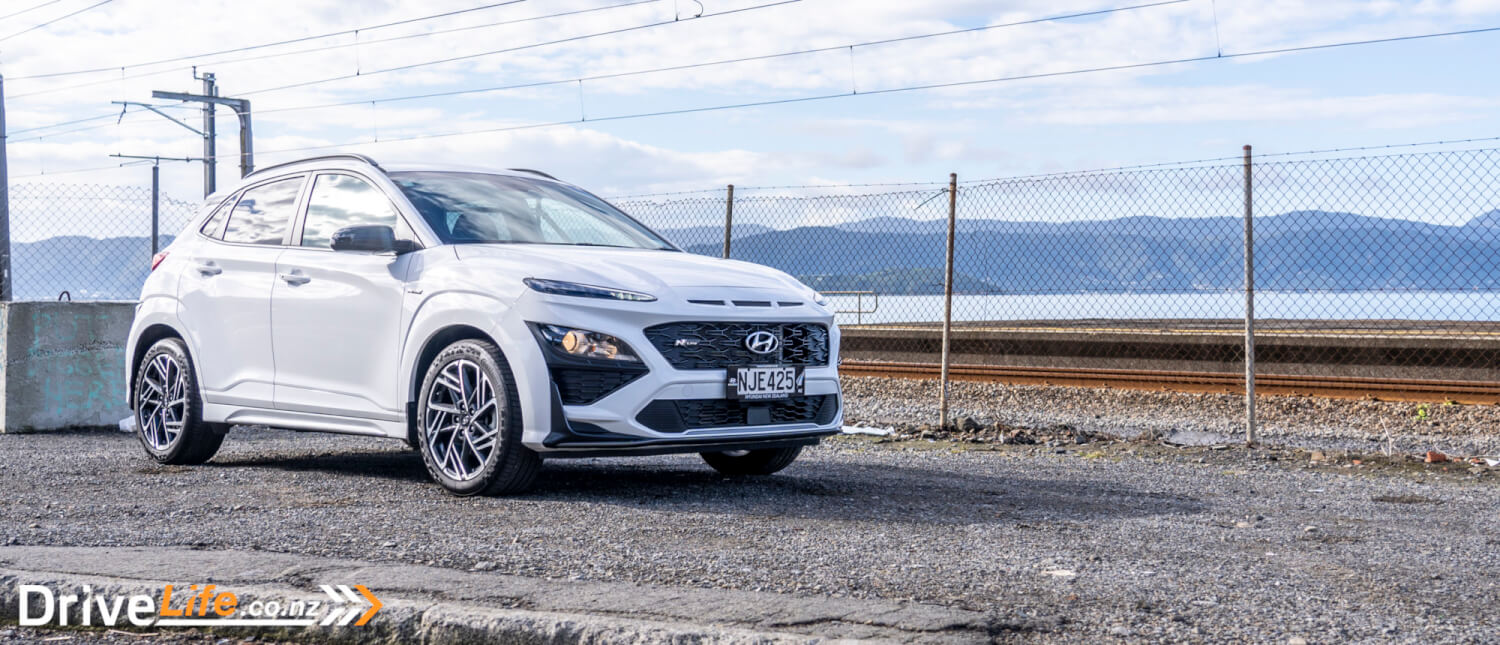
I used the car in Eco mode quite a bit, but with that DCT transmission, it made the gearbox even more sluggish, so I left the drive mode in SMART instead. You can also pick Comfort mode. In Sport mode, the word SMART goes red to let you know, and changes to blue for Eco mode. In Eco mode and on the move, the transmission changes up very quickly to achieve maximum fuel economy. Admittedly, the engine has so much torque you don’t really notice it. The car does remember your drive mode, so stick it in SMART and leave it there.
As mentioned, my week with the Kona N Line included a drive over the Remutaka Hill to Masterton. Since this is the sporty version of the Kona (until the Kona N comes out, at least), this should be where the car really shines. And it does ok; thank God for AWD, otherwise I think it’d be a real handful on the twisty bits. As mentioned, that exhaust doesn’t make any childish noises (a shame) and it needs some character. It goes very well and is always ready to go, but feels a bit, I guess, bland. Still, 146kW in a car this size is going to help on a windy road.
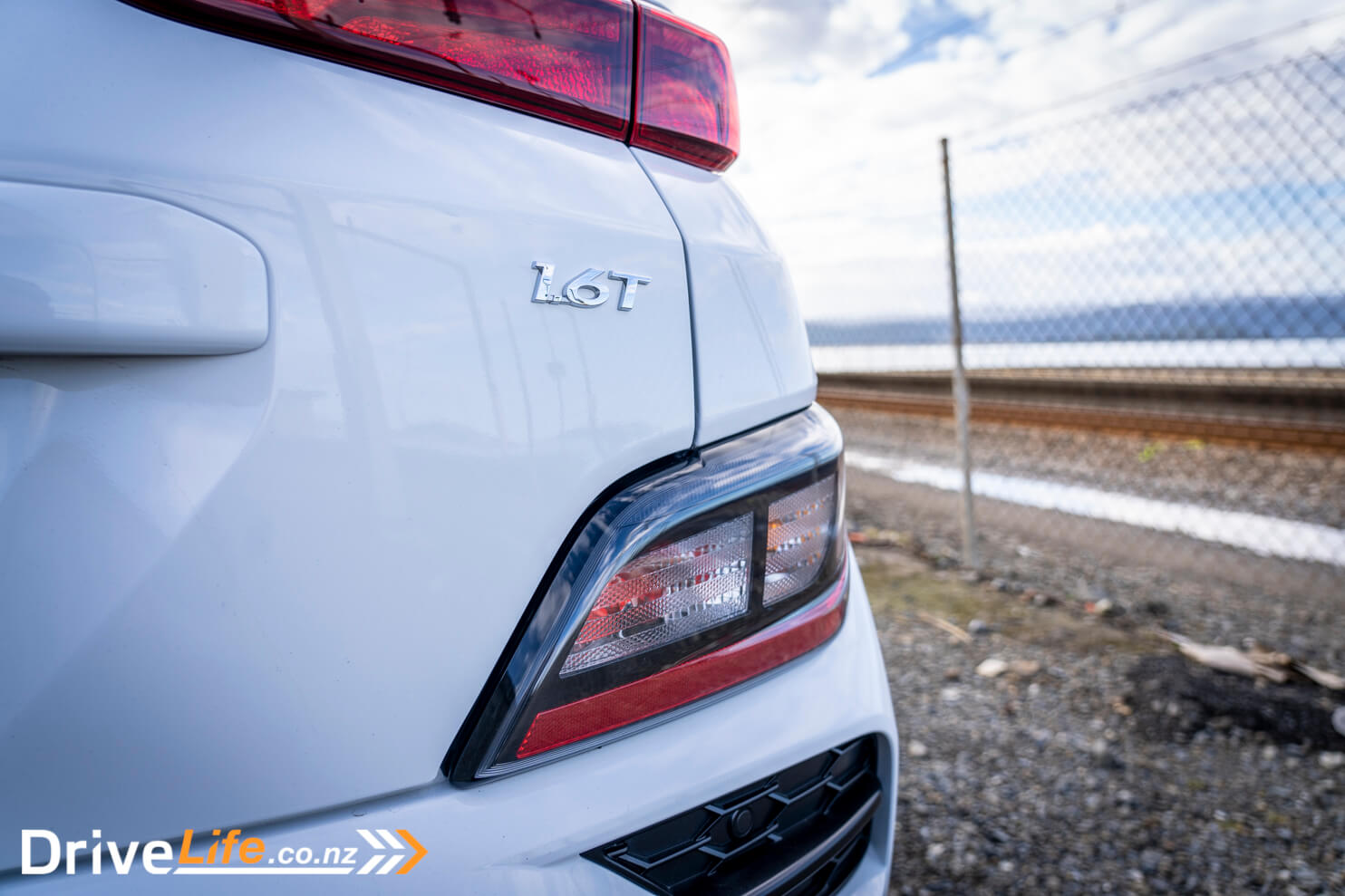
Midrange power is excellent, and with that torque can really help you get quickly around any corner. With that AWD, you can get the power down to the road with very little wheelspin, even on a tight bend. The brakes need a good shove to work, and the pedal feels like you are pushing on a piece of wood. This was both a surprise and a let-down for me. There’s very little feedback from the brakes.
Even in Sport mode, the steering feel is also a bit lacking, and it’s hard to know what’s happening up front of the car. Hyundai says that the steering is fine-tuned to match the new suspension character as well as to fit the new tyres. This set up is applied to the whole Kona range, including the Kona N Line. The only exception is the Kona N Line received specific steering tuning to match the character of the vehicle but for me, that hasn’t been successful as far as steering feel goes.

I don’t want this review to come across as too negative of the Kona N Line, as it’s a nice drive, but I was surprised that for a sporty model there’s no steering wheel paddles to change gears. On the Remutaka Hill, my fingers kept going behind the steering wheel to manually change up or down, but found nothing.
Handling-wise, the car can feel top-heavy, and at times the rear end felt a bit twitchy. I wouldn’t call it bad – again AWD helps a lot here – but it can still hustle if you want it to, and in the right hands. I wouldn’t like to see someone on their restricted license having a decent go with this car. The car will grip if you keep pushing it harder around a bend, and will eventually turn into understeer. I’m pretty sure that in the wet on a bend, you could get a nice 4-wheel drift going – if you wanted it to, of course.
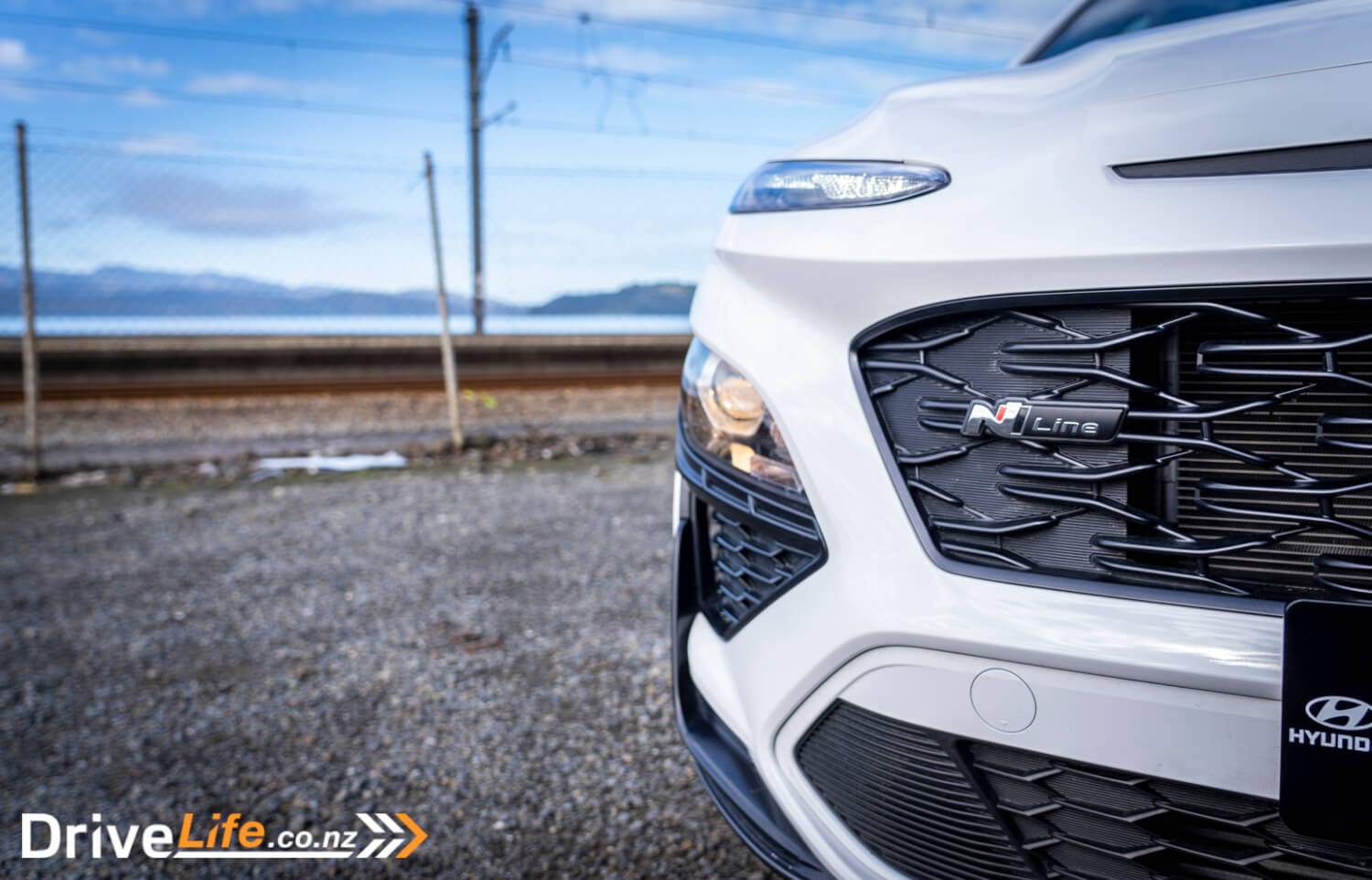
When I picked up the Kona N Line, I oohed and aahed over the diff lock button, expecting this to come into play in Sport mode. However, the diff lock button (on the centre console) is only for speeds below 40km/h, and it’s for locking the diff when needed in mud, sand, or snow. If you turn it on and go over 40km/h, it will change into AWD automatic mode, which means basically the diff lock button is off.
Back on the Daily Drive and on the positive side of things, the ride in the Kona N Line is very good, especially for a small SUV. There’s been some changes to the new model’s suspension, with modified stabiliser bars for better ride comfort and isolation. The rear bump stop is also modified, bringing benefits for primary ride and lateral body control.
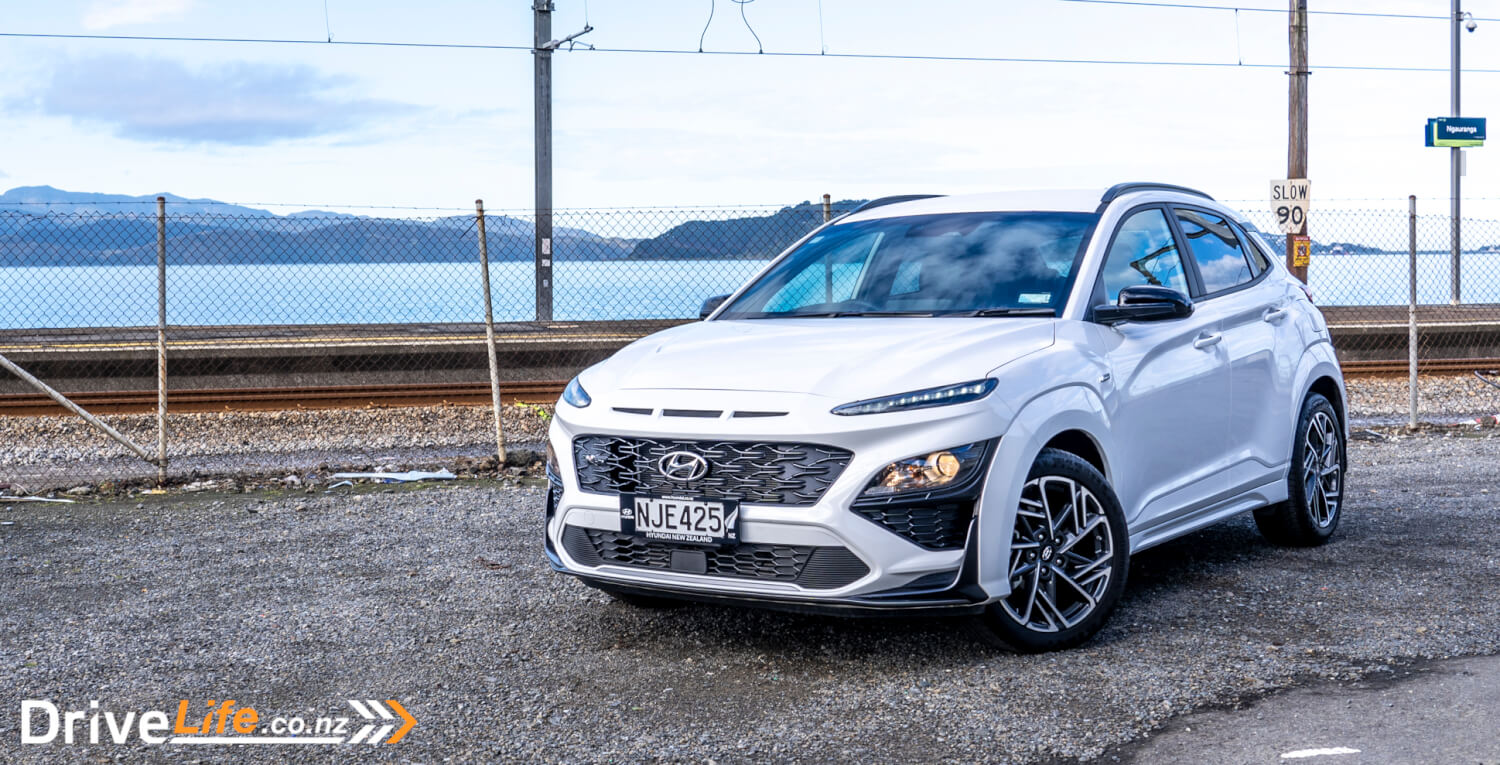
There’s sliding sun visors (which I love), and now the car comes standard with SatNav and adaptive cruise control – two things that Rob mentioned the car was missing when he reviewed the (then) top-spec Limited version. Good to see that Hyundai listens, and responds.
Adaptive cruise will bring the car to a stop, which was great to see. There’s also Lane Keep Assist but typical of Hyundai, it’s fairly aggressive and I turned it off. Unfortunately, due to ANCAP requirements, it will turn itself back on every time you get in the car. There’s a bunch of new safety features fitted to the new Kona, including an active blind-spot monitor (you can’t change into another lane if there’s someone there).
New to this model is Leading Vehicle Departure Alert (LVDA), which alerts the driver if they do not react fast enough when the vehicle ahead of them starts moving. Another is Lane Following Assist (LFA), which automatically adjusts steering to assist the driver to keep in the centre of the lane.
Another upgraded feature is Forward Collision-Avoidance Assist (FCA) with pedestrian and new, cyclist detection. The optional FCA uses a sensor in addition to a camera to better detect potential collisions. This increases the detection range and types of targets that can be detected and ensures the system works even in bad weather conditions. If the system senses a potential collision and the driver fails to react in time, it automatically applies the brakes.

Rear Cross-Traffic Collision-Avoidance Assist (RCCA), also a first for the new Kona, works to avoid a collision when backing up by applying the brakes if another vehicle is detected. This is an upgrade from the previously available Rear Cross-Traffic Collision Warning, which only provided a warning.
Here’s a list of the new safety features in this generation Kona:
Hyundai SmartSense Active Safety Features
· Blind-Spot Collision-Avoidance Assist (BCA) [NEW]
· Rear Cross-Traffic Collision-Avoidance Assist [NEW]
· Smart Cruise Control (SCC) with stop and go [NEW]
· Leading Vehicle Departure Alert (LVDA) [NEW]
· Lane Following Assist (LFA) [NEW]
· Safe Exit Warning (SEW) [NEW]
· Rear Occupant Alert (ROA) [NEW]
· Forward Collision-Avoidance Assist (FCA) (now with [NEW] optional cyclist detection)
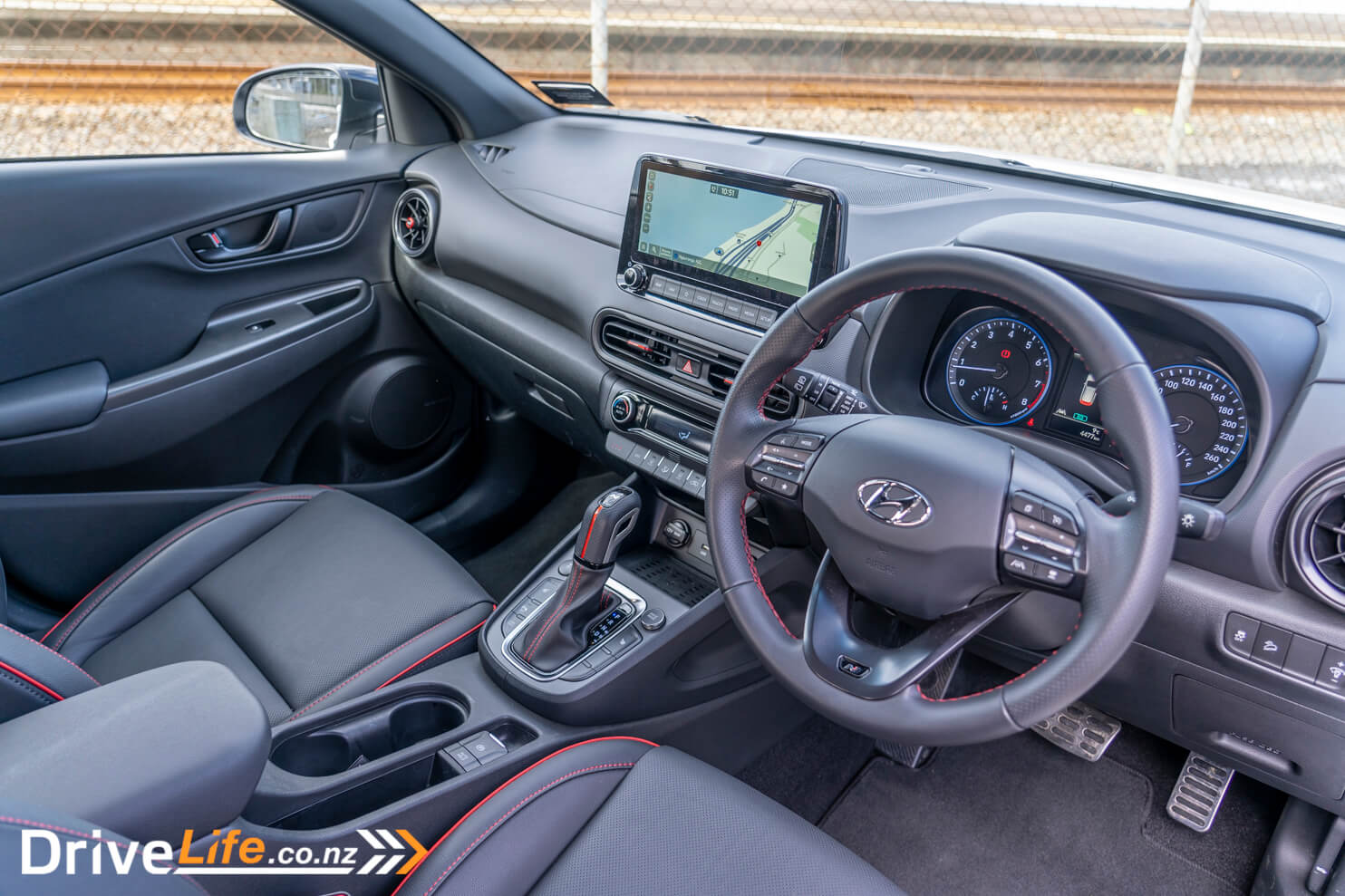
Audio quality is surprisingly good, with crisp, clear audio and some nice separation. No complaints there at all. Like other Kia and Hyundai models, you also have the option of Sounds of Nature, where you can have some ambient noise coming through the speakers if you want. These include things like Busy Café, Warm Fireplace, Calm Ocean Waves, Rainy Day. Something for the kids to play with, or fight over. There’s also a Quiet Mode for audio, a little like Joe Mode on the Tesla Model 3. Quiet mode limits sound to the front speakers only and allows a maximum volume of 7. It might help keep those toddlers in the back seat asleep.
You will get tyre noise from those Conti Premium Contact 6 tyres on coarse chip seal. It’s not massively bad, and we’ve seen the same result from those tyres on coarse chip in other cars. Road noise is well subdued, and overall the Kona N Line is a quiet car on the Daily Drive.

I mentioned there’s no steering wheel paddles in this sporty Hyundai, and there’s also no heads-up display, which I expected at this price point. Another weird change is the lack of the LED headlights from the Limited model to cheaper projector-headlamps. Since this is the top-spec Kona right now, that seems to be a big omission.
Hyundai suggests a combined fuel consumption of 6.2L/100Km. After 600Km of mixed driving conditions, I managed 8.2L/100Km. It’s not bad but feels high for a 1.6-litre car. But keeping in mind its sporty nature and the turbo, it’s an expected result. Your mileage may vary.
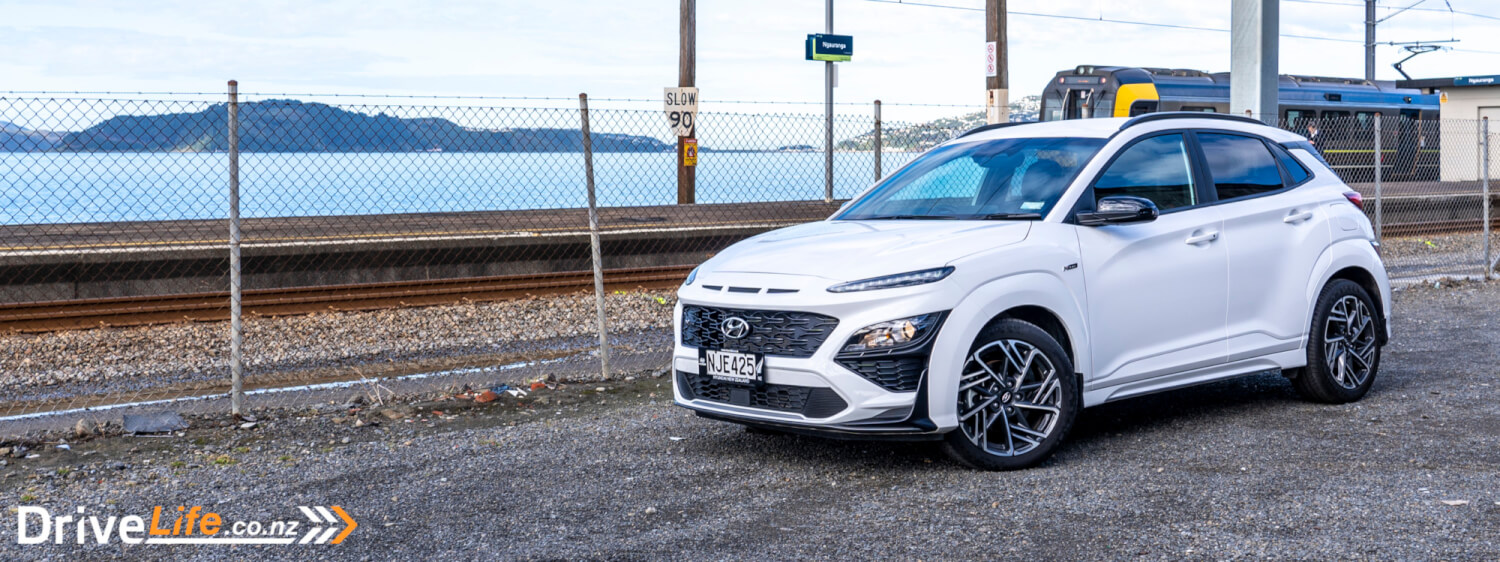
What’s The Competition For The 2021 Hyundai Kona N Line?
While at first glance the Kona N Line seems to be at the cheaper end here, all of the more expensive models shown are one size up.
| Brand/Model | Engine (all petrol) | Power/Torque kW/Nm | Seats | Cargo capacity, litres | Fuel L/100km | Price |
| Skoda Karoq Sportline AWD | 2.0-litre turbo 4-cylinder | 140/320 | 5 | 521 | 6.9 | $55,990 |
| Mazda CX-5 AWD SP25T | 2.5-litre, turbo 4-cylinder | 170/420 | 5 | 455 | 8.2 | $55,595 |
| VW T-Roc TSI R-Line 4WD | 2.0-litre turbo 4-cylinder | 140/320 | 5 | 390 | 6.8 | $52,990 |
| Seat Ateca FR 4Drive | 2.0-litre turbo 4-cylinder | 140/320 | 5 | 485 | 6.8 | $52,990 |
| Ford Escape ST Line AWD | 2.0-litre, turbo 4-cylinder | 183/387 | 5 | 556 | 8.6 | $50,990 |
| Hyundai Kona N Line AWD | 1.6-litre, turbo 4-cylinder | 146/265 | 5 | 375 | 6.2 | $49,990 |
| Honda CR-V Sport Premium AWD | 1.5-litre, turbo 4-cylinder | 140/240 | 5 | 522 | 7.5 | $43,990 |
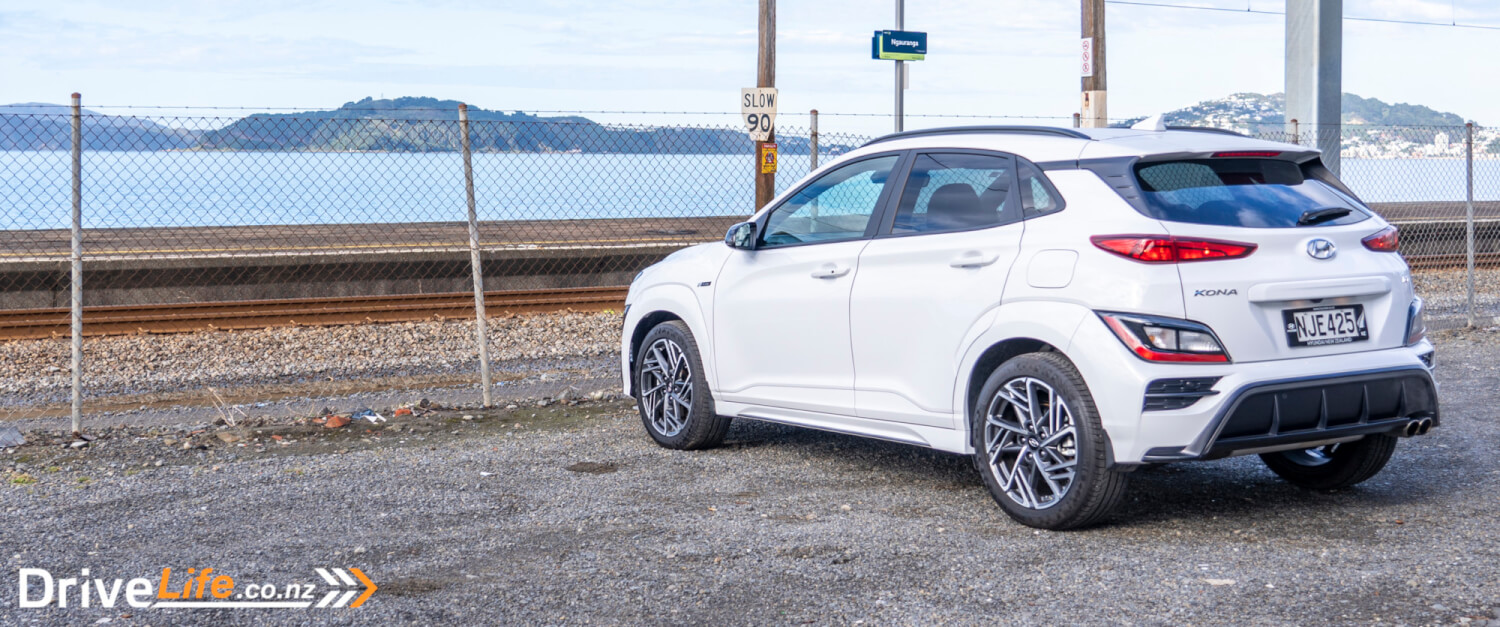
What’s The Pros And Cons Of The 2021 Hyundai Kona N Line?
| Pros Performance Audio Safety features Design Central display quality/infotainment system Safety of all-wheel-drive | Cons No paddle shifters Transmission Steering and brake feel Cheap-feeling interior |
| Vehicle Type | 5-door, all-wheel-drive, performance small-SUV |
| Starting Price | $49,990 |
| Price as Tested | $49,990 |
| Engine | 1.6-litre, 4-cylinder turbocharged petrol |
| Power, Torque kW/Nm | 146@6,000 rpm 265@1,600-4,500 rpm |
| Transmission | 7-speed dual-clutch automatic |
| Spare Wheel | Space saver |
| Kerb Weight, Kg | 1,395 |
| Length x Width x Height, mm | 4215x1800x1575 |
| Cargo Capacity, litres Seats up/seats down | 374/1,156 |
| Fuel capacity, litres | 50 |
| Fuel Efficiency, L/100Km | Advertised Spec – combined – 6.2 Real World Test – combined – 8.2 Low Usage: 0-6 / Medium Usage 6-12 / High Usage 12+ |
| Towing Capacity Kg, unbraked/braked | 600/1,300 |
| Turning circle, metres | 10.6 Small: 6-10m / Medium 10-12m / Large 12m+ |
| Warranty | 10 year / 200,000 km anti perforation corrosion body warranty 3 year / 100,000 km mechanical warranty 3 year / 100,000 km roadside assistance package |
| ANCAP Safety Ratings | 5 Stars |


